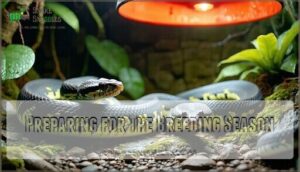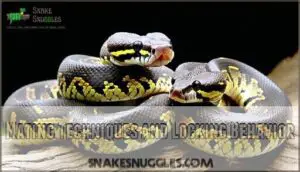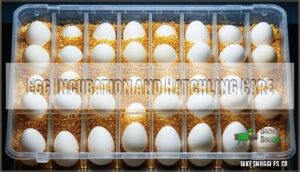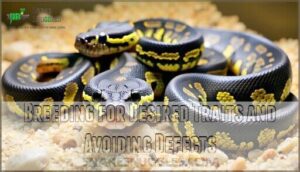This site is supported by our readers. We may earn a commission, at no cost to you, if you purchase through links.

Temperature cycling mimics natural seasons, triggering breeding behavior. Collection management software is essential for tracking breeding pairs and genetic outcomes. Proper record-keeping prevents inbreeding and ensures ethical practices that prioritize animal welfare over profits.
The process demands patience, as follicles develop over months before ovulation occurs. Timing is vital for successful reproduction, making careful planning and observation key to a thriving breeding program.
Table Of Contents
- Key Takeaways
- Starting a Ball Python Breeding Program
- Preparing for The Breeding Season
- The Breeding and Egg Laying Process
- Egg Incubation and Hatchling Care
- Genetics, Morphs, and Program Management
- Frequently Asked Questions (FAQs)
- How to breed a ball python?
- How to breed a ball python morph?
- Are ball pythons good for breeding?
- When do ball pythons breed?
- How Often Should I Feed My Hatchlings?
- What is the Temperature Range for the Incubator?
- Is There a Difference in the Incubation Period for Female and Male Eggs?
- How Can I Tell if a Female Ball Python is Ready to Breed?
- How to start ball python breeding?
- What month is breeding season for ball pythons?
- Conclusion
Key Takeaways
- You’ll need healthy breeding adults with females weighing at least 1,200 grams and males 700+ grams to prevent serious complications like egg binding and ensure successful reproduction.
- You must create proper environmental conditions by cycling temperatures to 75-78°F at night and maintaining 88-90°F incubation temperatures with 90-99% humidity for optimal egg development.
- You’ll want to implement systematic record-keeping using collection management software to track genetic combinations, prevent inbreeding, and monitor breeding outcomes for long-term program success.
- You should prioritize genetic testing and ethical breeding practices to avoid defect-prone morph combinations while focusing on animal welfare over profit margins.
Starting a Ball Python Breeding Program
Starting a ball python breeding program requires careful selection of healthy adults that meet specific weight and age requirements. You’ll need females weighing at least 1,200 grams and males at 700 grams minimum to guarantee successful reproduction and avoid serious health complications like egg binding.
Choosing Healthy Breeding Adults
Breeding stock selection forms the foundation of your ball python program’s success. You’ll want to focus on three critical health indicators:
Healthy breeding stock is your program’s cornerstone—choose wisely for reptilian success
- Visual assessment – Look for bright eyes, smooth skin, and active tongue flicking
- Health screening protocols – Conduct PCR testing for diseases and parasite checks
- Genetic diversity assessment – Verify morph genetics and avoid defect-prone bloodlines
Proper snake weight management and adult nutrition optimization guarantee your breeding stock maintains peak condition for successful reproduction. To achieve prime breeding results, consider the breeding readiness guidelines for your ball pythons.
Determining Proper Breeding Size and Age
Two vital indicators determine your breeding program’s foundation: females must reach 1200 grams and 2-3 years old, while males need 700 grams at 8 months minimum. These Snake Weight Limits and Breeding Age Guidelines prevent egg binding and health complications.
Proper Size Requirements guarantee your Ball Python Breeding success, as undersized animals face serious risks during reproduction. Understanding breeding age requirements is vital for a successful breeding program.
Setting Breeding Objectives and Goals
Your breeding objectives should align with your long-term vision and available resources. Define whether you’re targeting specific morph combinations, building breeding pairs for genetic diversity, or focusing on market research to identify profitable traits.
Establish clear breeding strategy objectives, maintain detailed genetic data records, and connect with experienced breeders through breeder networking.
Your breeding program’s success depends on realistic breeding size goals and systematic genetic planning approaches.
Preparing for The Breeding Season
Once you’ve selected your breeding stock, preparing for the breeding season requires precise environmental manipulation to trigger natural reproductive instincts. You’ll need to carefully adjust temperature and lighting cycles starting in October to simulate winter conditions that signal breeding time.
Mimicking Natural Temperature and Lighting Cycles
Successful climate simulation replicates West Africa’s seasonal patterns, triggering your ball python’s natural breeding cycle. Gradual temperature drops over 7-10 days prevent stress while photoperiod management synchronizes reproductive hormones for ideal ovulation timing. Understanding temperature gradients is vital for creating an ideal breeding environment.
- Temperature Control: Drop nighttime temperatures to 75-78°F while maintaining 88-92°F daytime highs during breeding season
- Lighting Schedules: Implement 10 hours light/14 hours dark cycles using automated timers for consistency
- Thermal Gradients: Create proper temperature zones that allow active thermoregulation throughout the enclosure
- Photoperiod Management: Maintain strict lighting routines to increase pairing success rates by up to 30%
- Climate Simulation: Use thermostats and data logging tools to automate gradual shifts and monitor breeding cycle progress
Managing Humidity and Enclosure Setup
Your breeding room’s humidity levels can make or break your program’s success. Maintain 50-60% humidity using proper Ventilation Systems and strategic water bowl placement. Design your Enclosure Setup with appropriate Substrate Options like cypress mulch for moisture retention. Monitor Temperature Gradients carefully, as humidity affects thermal regulation.
Consider installing a dedicated incubator room with controlled humidity for future egg incubation needs. Effective humidity management also involves using humidity control devices to guarantee ideal breeding conditions.
Using Collection Management Software
Modern Snake Breeding Management software transforms your breeding program from guesswork into precision science. These platforms simplify data tracking while providing powerful breeding analytics that help you make informed decisions about your collection.
- Morph Management: Track genetic combinations and predict offspring outcomes
- Virtual Incubator Management: Monitor temperature, humidity, and development stages
- Record Optimization: Store breeding dates, weights, and health records digitally
- Software Integration: Sync with scales, thermostats, and monitoring equipment
- Collection Management Software: Access your data anywhere, anytime through cloud-based platforms
You’ll manage your collection more effectively when everything’s organized in one place.
The Breeding and Egg Laying Process
Once your breeding adults reach proper weight and age, you’ll witness the fascinating process of follicle development, mating behavior, and egg production unfold over several months.
Understanding these critical stages will help you recognize breeding signs and prepare for successful egg laying.
Cycling, Follicle Development, and Ovulation
Your female’s body language tells the story of successful cycling. After months of Temperature Cycling, follicles begin their growth journey from 8-10mm to 20-25mm before Ovulation.
Watch for the telltale pre-ovulatory swell—a distinct bulge lasting 24-48 hours that signals peak Reproductive Health. This critical Ovulation Timing determines your breeding window and upcoming Preovulation shed cycle.
Mating Techniques and Locking Behavior
Once your female shows signs of ovulation, it’s time to introduce males for breeding. Watch for courtship behavior like the male’s chin rubbing and body positioning along the female’s spine. When mating occurs, you’ll observe locking mechanics where the male’s hemipenes engage with the female’s cloaca. This lock can last 20 minutes to several hours, indicating successful mating strategies are working.
To increase the chances of successful breeding, understanding temperature gradients is vital for creating an ideal environment.
Pre-lay Shed and Egg Laying Signs
After successful mating, you’ll notice your female’s body changing as follicle growth accelerates. Watch for these preovulation shed cycle indicators:
- Ovulation signs – dramatic belly swelling and firmness
- Pre-lay care timing – maintain ideal temperatures consistently
- Egg laying preparation – provide secure nesting areas
- Egg bound prevention – monitor for prolonged straining behaviors
The preovulation shed usually occurs 2-3 weeks post-ovulation, signaling egg laying approaches within 30-50 days.
Egg Incubation and Hatchling Care
Once your female ball python lays her clutch, you’ll need to carefully transfer the eggs to an incubator within 24 hours to prevent developmental issues.
This critical phase requires precise temperature control at 89°F and proper humidity levels to guarantee healthy hatchlings emerge after 50-55 days of incubation.
Transferring and Incubating Eggs
After your female lays her clutch, you’ll need quick but gentle egg removal within 24 hours. Handle eggs carefully during transfer—they’re surprisingly delicate despite feeling firm. Mark the top side with a pencil before moving them to your incubator.
Choose between maternal incubation (letting mom do the work) or artificial incubation methods using vermiculite or hatchrite substrate.
Proper egg monitoring starts immediately, checking for viable white coloration versus yellowing slugs that won’t develop. For ideal results, consider using a Ball Python Incubator to maintain the required temperature and humidity levels.
Optimal Incubation Conditions
Your incubator’s success hinges on precise environmental control that mimics nature’s perfect conditions. Maintaining stable parameters guarantees your fertile eggs develop properly and avoid common incubation problems that plague many breeders.
Here are four critical factors for hatching success:
- Incubation Temperatures: Keep your incubator between 88-90°F consistently
- Humidity Levels: Maintain 90-99% relative humidity throughout the process
- Incubation Mediums: Use vermiculite or perlite at proper moisture ratios
- Air Exchange: Provide adequate ventilation while preventing moisture loss
Monitoring Development and Hatching Care
Your incubator transforms into a nursery as eggs near their hatching date, typically around day 50-55. Egg Candling is crucial during this stage, as it reveals developing embryos and helps identify Congenital Issues early on. Keep an eye out for pipping—the first crack in the shell signaling that hatching is imminent. Once Hatchlings emerge, they require immediate attention, including Hatchling Hydration monitoring and preparation for their First Shed, which usually occurs within 7-10 days.
| Development Stage | Timeline | What to Watch For | Action Required |
|---|---|---|---|
| Late Incubation | Days 45-50 | Increased movement via candling | Monitor temperature stability |
| Pipping | Day 50-55 | First crack in shell | Avoid handling, maintain humidity |
| Hatching | 24-48 hours after pip | Full emergence from shell | Provide hiding spots |
| Post-Hatch | 0-7 days | First Shed preparation | Plan Feeding Strategies |
Setting Up Hatchling Enclosures
Once your hatchling ball python emerges from the incubator, proper enclosure setup determines survival success. You’ll need specific equipment to create a safe environment where your new snake can thrive.
- Enclosure Size: Start with 20-gallon long tanks for ideal space
- Heating Options: Maintain 88°F hot spot using under-tank heaters
- Humidity Control: Keep levels at 50-60% with water bowls
- Substrate Choices: Use paper towels for easy monitoring during First Meals
To encourage natural behaviors, consider adding enrichment features to the enclosure.
Genetics, Morphs, and Program Management
Managing your ball python breeding program’s genetics requires careful planning to produce desired morphs while avoiding harmful genetic combinations. You’ll need systematic record-keeping tools and ethical breeding practices to maintain healthy bloodlines and build a successful program.
Breeding for Desired Traits and Avoiding Defects
Smart Ball Python breeding program success hinges on Morph Selection paired with genetic testing. You’ll avoid costly mistakes by screening for Recessive Gene carriers before pairing—preventing Spider wobble syndrome and Caramel Albino spinal defects. Ethical Breeding means prioritizing animal welfare over rare genetics profits. Modern Defect Mitigation through Trait Heritability analysis keeps your program profitable and humane.
Regular cleaning of the enclosure can help prevent common parasite infestations.
Record Keeping and Virtual Incubator Tools
Modern breeding programs depend on accurate Digital Logs and Data Analysis to track your morph production success. Cloud Backup protects years of breeding records, while Virtual Incubator software monitors each clutch automatically. Incubator Automation removes guesswork from temperature control, boosting your hatch rate substantially. Accurate record keeping is easier with reptile data loggers.
- Reptile Collection Management software tracks breeding pairs and genetic combinations
- Digital temperature and humidity logs prevent costly incubation mistakes
- Cloud-based systems protect breeding records from hardware failures
- Automated alerts notify you of critical temperature or humidity changes
Ensuring Health, Ethics, and Quality Assurance
Your Snake Breeding Program’s success hinges on rigorous Quality Assurance protocols that prevent Morph-related defects through thorough genetic testing. Ethical breeding practices demand Veterinary oversight to screen for hereditary issues, while genetic tests verify trait authenticity and maintain Genetic diversity.
Market responsibility requires transparent morph production standards, ensuring healthy offspring rather than prioritizing profit over animal welfare in your breeding operations.
Frequently Asked Questions (FAQs)
How to breed a ball python?
To breed ball pythons successfully, you’ll need healthy adults: females weighing 1200+ grams and males 700+ grams.
Cycle temperatures and lighting in October, then pair snakes after proper conditioning for ideal reproductive success.
How to breed a ball python morph?
Like crafting a masterpiece from raw clay, you’ll selectively pair morphs with compatible genetics, ensuring proper weights and cycling conditions while tracking inheritance patterns to produce your desired offspring combination.
Are ball pythons good for breeding?
Yes, ball pythons excel at breeding when you’re ready for the commitment. They’re hardy, produce valuable offspring, and don’t require extreme setups, making them perfect beginner breeding snakes.
When do ball pythons breed?
You’ll usually cycle your ball pythons starting in October to trigger their natural breeding instincts. Females reach breeding readiness by November through January when they’ve hit 1200 grams and proper age requirements.
How Often Should I Feed My Hatchlings?
Young pythons are like growing teenagers—they need fuel for their rapid development!
Feed your hatchlings every 5-7 days with appropriately sized prey (10-15% of their body weight) to support healthy growth.
What is the Temperature Range for the Incubator?
You’ll want to maintain your incubator at around 89°F for ideal ball python egg development. This temperature creates the sweet spot where embryos develop properly without overheating or stalling out completely.
Is There a Difference in the Incubation Period for Female and Male Eggs?
Like clockwork precision, ball python eggs don’t discriminate by sex during incubation. You’ll find both male and female eggs hatch within the same 50-55 day timeframe at 89°F, making gender irrelevant to your timing.
How Can I Tell if a Female Ball Python is Ready to Breed?
Female ball pythons are ready to breed when they’re at least 1200 grams and 2-3 years old. You’ll notice follicle development causing body swelling, followed by significant enlargement during ovulation.
How to start ball python breeding?
Despite concerns about complexity, you’ll master ball python breeding by ensuring females weigh 1200+ grams and males 700+ grams.
Start cycling temperatures in October, create proper lighting conditions, then introduce pairs during breeding season.
What month is breeding season for ball pythons?
Ball python breeding season occurs during winter months, usually November through February. You’ll replicate their natural African dry season by cycling temperatures and lighting starting in October for ideal breeding success.
Conclusion
Success awaits those who master the fundamentals. Your ball python breeding program depends on careful preparation, precise environmental control, and thorough record-keeping. You’ve learned the essential steps, from selecting breeding adults to incubating eggs and caring for hatchlings.
Patience drives results—follicle development takes months, not weeks. Maintain proper temperatures, humidity levels, and genetic tracking throughout the process.
With dedication to these proven methods, you’ll establish a thriving ball python breeding program that produces healthy offspring while maintaining ethical standards in the reptile community.
- https://www.wilbanksreptiles.com/blogs/ball-python/the-ultimate-beginners-guide-to-buying-a-ball-python
- https://www.americanmadeexotics.com/breeding-ball-pythons-article.html
- https://livingartreptiles.tripod.com/id46.html
- https://community.morphmarket.com/t/help-in-choosing-my-first-bp/46939
- https://animaldiversity.org/accounts/Python_regius/














